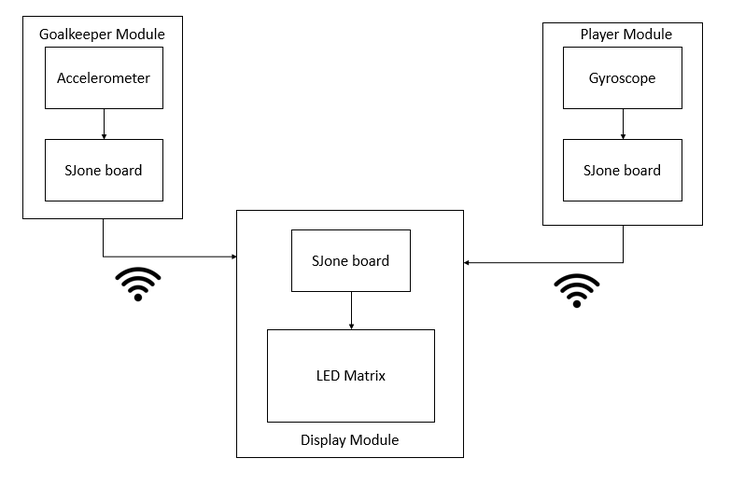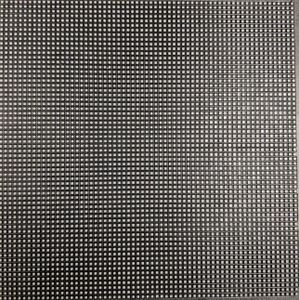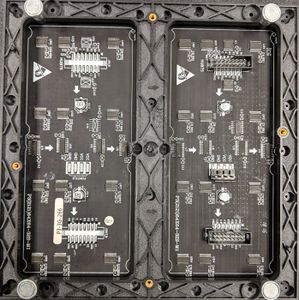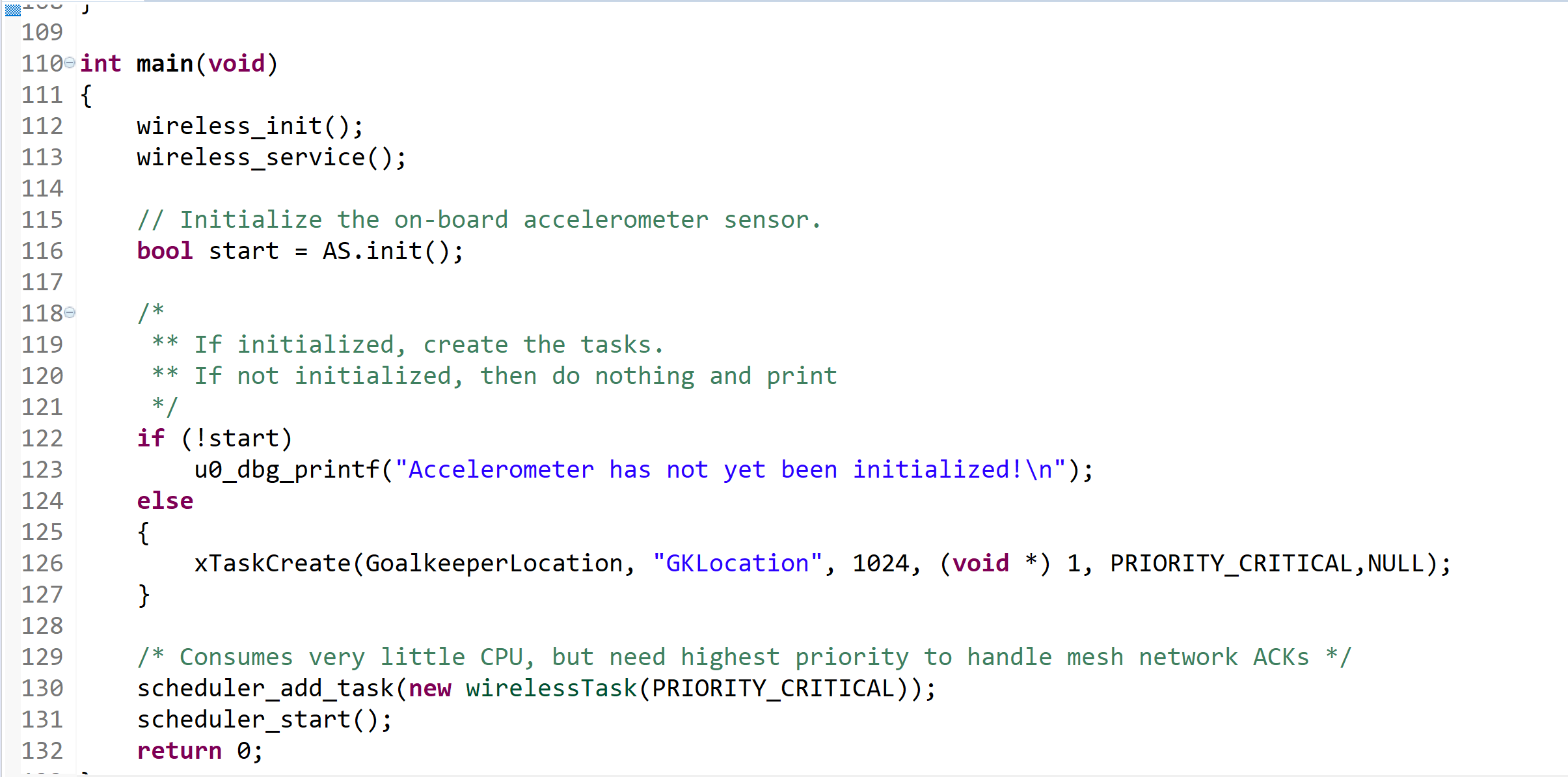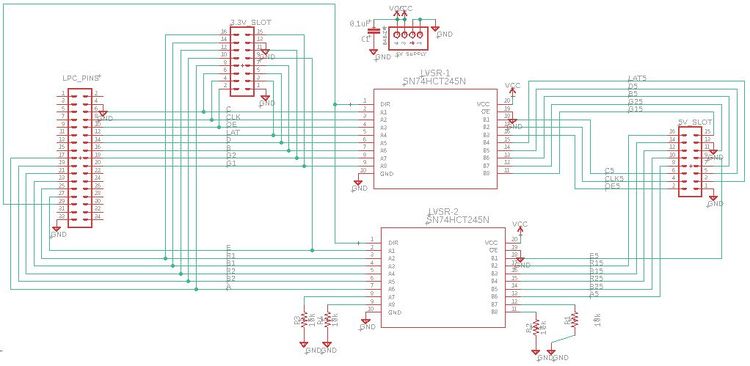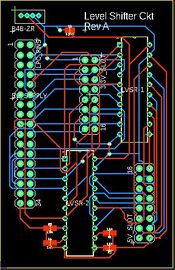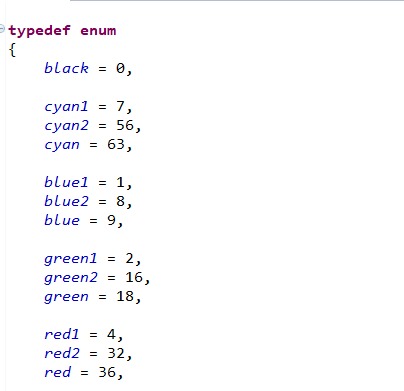Difference between revisions of "F18: Goals of Glory"
Proj user17 (talk | contribs) (→Conclusion) |
Proj user17 (talk | contribs) (→Conclusion) |
||
| Line 450: | Line 450: | ||
== Conclusion == | == Conclusion == | ||
| − | We were successfully able to achieve gesture-based gaming capabilities via our game- Goals of Glory. Our project has been a huge success since we not only got it working but also had a great time playing and optimizing it to tune it for user application. In terms of learning, we are happy that we got introduced in graphics design. We were able to develop a game where 2 players i.e. a player and goalkeeper are able to play wirelessly and corresponding game visuals are displayed on LED Matrix in real time. This project helped us to work on different modules of an embedded system such as a display, wireless and gyroscope, an accelerometer and combine it into a ready-to-use hardware package. | + | We were successfully able to achieve gesture-based gaming capabilities via our game- Goals of Glory. Our project has been a huge success since we not only got it working but also had a great time playing and optimizing it to tune it for user application. In terms of learning, we are happy that we got introduced in graphics design. We were able to develop a game where 2 players i.e. a player and goalkeeper are able to play wirelessly and corresponding game visuals are displayed on LED Matrix in real time. This project helped us to work on different modules of an embedded system such as a display, wireless and gyroscope, an accelerometer and combine it into a ready-to-use hardware package. The project also helped us use FreeRTOS which we learned in CMPE 244 class. Thus we were able to design an attractive and ready to use a game console package encompassing gesture based gaming |
=== Project Video === | === Project Video === | ||
Revision as of 14:49, 19 December 2018
Contents
Project Title
Goals of Glory
Abstract
Gesture-based gaming is getting tremendous adoption due to immersive gameplay and increased player engagement. Goals of Glory is a classic penalty shootout game where 2 players can play wirelessly, and the corresponding game visuals are displayed on the LED Matrix in real time. The logic for player movement is based on the output from a Gyroscope and an Accelerometer embedded on MPU 6050 whereas accelerometer on the SJone helps drive goalkeeper movements. Thus the motion of player leg movements to kick and hand movements of the goalkeeper to stop the ball is mapped and the corresponding game animations are displayed on 64x64 LED Matrix. The LED matrix is interfaced to the SJone board in such a way that the main SJone board controlling the LED Matrix receives commands wirelessly from hand and leg movements of each player via the Nordic wireless mesh network. Three display screens are developed for the game UI- Start screen, Game screen, and Result screen. Thus, by playing Goals of Glory, players can experience gesture-based gaming capabilities.
Objectives & Introduction
Introduction
Our project is divided into 4 modules
1) LED Module: The 64x64 LED matrix is driven by a Master SJone board which is responsible to map game visuals.
2) Wireless Module: Responsible for communication medium between the goalkeeper, player, and the main SJone board
3) Player Module: This module is responsible for getting the player movement that will be mapped to drive game visuals
4) Goalkeeper Module: This module is responsible for getting the goalkeeper movement that will be mapped to drive game visuals
Objectives
Our project involved a focused and rigorous approach to testing each module functionality and make necessary changes thereafter.
- Design power management PCB
- Developing game visuals for the penalty shootout game.
- Developing logic for display tasks such as curving the ball, selecting the player and ball color.
- Implement RGB LED matrix driver
- Perform RGB LED matrix pin layout with the SJone board and have a deep understanding of how a single or group of LED's are driven.
- Perform accelerometer driver
- Perform nordic wireless driver
- Have a proper synchronization between the player SJone board and goalkeeper SJone board
- Examine overall system and make necessary tweaks
- Prepare the entire system for demo purpose which includes gloves and mounting pads to mount hardware equipment
Team Members & Responsibilities
- Player Movements
- Aniket Phatak
- Bhargav Shashidhara Pandit
- Goalkeeper Movements
- Tahir Rawn
- Harmeen Joshi
- Display (RGB LED Matrix)
- Harmeen Joshi
- Tahir Rawn
- Satya Sai Deepak. Naidu
- Wireless (Nordic)
- Aniket Phatak
- Bhargav Shashidhara Pandit
- PCB Design
- Satya Sai Deepak. Naidu
Game Stats:
- 2-Player Penalty shootout Game
- 3-sec timer for each player to shoot
- Press switch on the main SJOne board to start
- Move the Goalkeeper SJone board left-right to have a corresponding movement of LED Matrix
- Control the ball movement via player SJone board to give direction i.e. left, right or straight
- Highest player to score wins and is displayed on the result screen
Schedule
| Week# | Date | Task | Status |
|---|---|---|---|
| 1 | 09/25 |
|
|
| 2 | 10/02 |
|
|
| 3 | 10/9 |
|
|
| 4 | 10/23 |
|
|
| 5 | 10/30 |
|
|
| 6 | 11/06 |
|
|
| 7 | 11/13 |
|
|
| 8 | 11/20 |
|
|
| 9 | 11/27 |
|
|
| 10 | 12/4 |
|
|
| 11 | 12/19 |
|
|
Parts List & Cost
| Item# | Part Desciption | Vendor | Qty | Cost |
|---|---|---|---|---|
| 1 | SJOne Boards | Preet | 3 | $240.00 |
| 2 | 64x64 RGB LED Matrix | Sparkfun | 1 | $75.00 |
| 3 | Power Adaptor Cable | Amazon | 1 | $9 |
| 4 | PCB | PCBWay [1] | 10 | $30 |
| 5 | MPU 6050 | Amazon | 2 | $11 |
| 6 | WiFi Antenna | Amazon | 3 | 24 |
| 7 | Mounting gloves | Amazon | 1 | $20 |
| 8 | Power Bank | Amazon | 2 | $24 |
| 9 | Miscellaneous (Jumper wires, Connectors, SMD's) | CMPE Lab 294 | $5 | |
| 9 | Total |
Design & Implementation
In this section, we would be discussing the design considerations for our project - Goals of Glory which would be covered in the following sections. The hardware design gives a brief explanation of the hardware components used. This is followed by a hardware interface that is employed in our project in order to facilitate communication between the hardware devices. Finally, we discuss the software design aspects of the project and complete this section with the discussion of the implementation of the project.
Hardware Design
The Hardware design for our project Goals of Glory involves usage of 3 SJone boards, a 64x64 LED matrix, MPU6050 gyroscope & accelerometer sensor, MMA8452Q accelerometer (onboard sensor) and Nordic wireless (nRF24L01+).
LED Matrix
A 64x64 RGB LED Matrix Panel is used as a display. It has 4096 full-color RGB LEDs. Each LED can be independently addressed and controlled. The LED matrix display is constructed using a decoder to decode address rows. A 64 bit Shift register should be clocked for enabling the color. When the row is low we need to select which all pixels in the column are to be configured with the required color. This is done by clocking the 64Bit shift register. There are 6 64Bit registers each for R1, R2, B1, B2, G1, and G2. A single clock is interfaced to all these 6 64bit shift registers. So at once we shift and fill the required color for the column display. Once the clocking and shifting the register is completed we need to latch this data to the register. The register data is sent out to all the row lines and that Row line which is pulled low by the decoder will receive this data and corresponding pixels are turned on.
LED matrix pins:
| S.NO | RGB LED pins | SJone GPIO pins |
|---|---|---|
| 1 | R1 | P1.20 |
| 2 | G1 | P2.7 |
| 3 | B1 | P1.22 |
| 4 | R2 | P1.23 |
| 5 | G2 | P2.6 |
| 6 | B2 | P1.28 |
| 7 | A | P1.29 |
| 8 | B | P2.5 |
| 9 | C | P2.0 |
| 10 | D | P2.4 |
| 11 | E | P1.19 |
| 12 | CLK | P2.1 |
| 13 | OE | P2.2 |
| 14 | LAT | P2.3 |
| 15 | VCC | 3.3V |
| 16 | GND | GND |
MPU 6050 Gyroscope and Accelerometer
Nordic Wireless
The SJOne board(LPC1758) is interfaced with Nordic wireless (nRF24L01+) chip using SPI.
The nRF24L01+ is a single chip 2.4GHz transceiver with an embedded baseband protocol engine, suitable for ultra low power wireless applications. The nRF24L01+ is designed for operation in the frequency band of 2.400 - 2.483GHz. The register map, which is accessible through the SPI, contains all configuration registers in the nRF24L01+ and is accessible in all operation modes of the chip. The embedded baseband protocol engine (Enhanced ShockBurst™) is based on packet communication and supports various modes from manual operation to advanced autonomous protocol operation. Internal FIFOs ensure a smooth data flow between the radio front end and the system’s MCU. Enhanced ShockBurst™ reduces system cost by handling all the high-speed link layer operations. nRF24L01+ supports an air data rate of 250 kbps, 1 Mbps and 2Mbps. The high air data rate combined with two power saving modes make the nRF24L01+ very suitable for ultra-low power designs.
In our project, we are employing three SJone boards each interfaced with a Nordic wireless chip. We use two boards for continuously transmitting direction data computed from the respective boards i.e player's and goalkeeper's movements. The third board receives the data transmitted from the other two boards. The three boards are uniquely identified based on their device ID (node address) as defined. In order for the boards to communicate smoothly without an interception, the communication has to occur on the same communication channel. This will prevent collision between two or more mesh networks.
Printed Circuit Board (PCB) Design
Introduction: The game uses a 64x64 LED Matrix which needs a 5v input supply. Since the board supplies 3.3v we level shift the voltage to 5v to avoid any unwanted flickering. So, we have decided to design a level shifter circuit. The design starts with the schematics and then designing the footprint. The design ends with creating the Gerber files and sending them to the manufacturing unit.
Schematics: The design was made in Eagle PCB design software. In preparing your schematics we encountered few challenges with the selection of equipment dimensions and dimension terminology(units). The designer should be aware of the dimensions of equipment that are to be used. After getting the idea of equipment, add the library of that equipment to eagle through manage library option. Now, the designer can get that item schematic and add it to the design schematics. Complete the schematics based on the circuit that the designer wants to implement. The above figure shows the schematics for a level shifter circuit.
Foot Print and Gerber Files:
After the schematics are done, you can see a BRD/SCH button i.e. schematic to board button. Using that button, the footprint page will be opened. Here you will be able to use some skills in designing a compact circuit. Selecting the trace width (in mils) accordingly based on your current ratings. We used a 2 layered 16 mils trace width for safer side to accommodate 4A flow of current. Place all your equipment in the square (board area) and can have positioned them upon the designers' will. Click on auto netlist button to run the simulations for possible tracing options
The designer can select one or draw the traces manually( manual is mostly preferred for better results). The footprint of out circuit is shown in Figure.2. Now, continue with DRC(design real check ) to check the possible errors while manufacturing. Make sure that there are no errors. After all the errors are cleared create the Gerber files for manufacturing company to provide those files to the manufacturing machines.
Few tips for schematics:
• Make sure the dimensions of auxiliary equipment size match the equipment. For example, the supply port size is 4mm pitch 4 pins if I use 2mm pitch 4pins the circuit cannot be practically implemented.
• Have a clear idea of the equipment and their availability in the market before getting started. Sometimes your design may be correct, but you will not be getting appropriate equipment for installing on circuit board. • Use Vcc and Gnd pins for reducing circuiting complexity.
Software Design and Implementation
Show your software design. For example, if you are designing an MP3 Player, show the tasks that you are using, and what they are doing at a high level. Do not show the details of the code. For example, do not show exact code, but you may show psuedocode and fragments of code. Keep in mind that you are showing DESIGN of your software, not the inner workings of it. This section includes implementation, but again, not the details, just the high level. For example, you can list the steps it takes to communicate over a sensor, or the steps needed to write a page of memory onto SPI Flash. You can include sub-sections for each of your component implementation.
Testing & Technical Challenges
Issues, Challenges and solutions to get past them
1. RGB LED Matrix Display driver
a) Writing the driver function on our own was a challenge. We were able to easily glow a single row in the matrix. However, the challenge lied in glowing a single pixel value at a specified location. And lack of datasheet made it even more difficult. Once we got the control over glowing a single LED (check updateDisplay function as shown above), we were able to implement various functions to draw lines, digits, text, ball, and goalkeeper.
b) Matrix flickering problem in which pixels on the screen weren't consistently bright when a particular animation was going on
- To solve this, we stopped clearing the whole display multiple times and cleared the specific pixels which mattered. Also, we were using a separate task, in which we were sending the data through the queue to control game task which was causing the task to wait on the queue till the data arrived which was causing flickering.So we removed this task and read the wireless data packet in controlGoalkeeper task and controlGame task separately
c) Ball animation to achieve swing
- We wrote an algorithm to find the path of the ball from the start point to endpoint (goalpost) to appear as if it were swinging
d) Handling screen refresh issue in which when we light up an LED, that would fade away in a few milliseconds
- The solution to this was creating an array of size 64x64 and a dedicated task to update the LED matrix.
e) The ungraceful transition of the ball from the one half of the LED matrix to the other half
- The solution to this calculated the new X value and new color in drawPixel function. Here we are calling calculateMatrixposition fucntion which will calculate and return new x value and new color value.
2. Designing the Gyroscope and Accelerometer driver for goalkeeper and player movements
a) Lose connection on MPU 6050
- The solution to this was hard wiring the MPU 6050 sensor to a general purpose PCB so that connection issues occur. Once this was done, we were able to successfully get the tilt.
b) Precision for getting accurate direction
- Since we have calculated five directions for ball movement, finding accurate gyroscope and accelerometer values with proper mapping was critical to our application.
3. Designing the Wireless driver a) System freeze when no data sent
- We introduced a NACK to indicate that no data sent hence whenever this condition occurs it waits for the new data to be sent.
4. Dimensions of power pins for the PCB design
a) Accommodate the exact dimensions of the 5V Power pin on the PCB design.
- Since there is no datasheet available for the 64x64 RGB LED Matrix, hence it was a difficult task. We used a basic approximation to determine the pin dimensions that would fit inside the PCB design such that it works just fine.
Conclusion
We were successfully able to achieve gesture-based gaming capabilities via our game- Goals of Glory. Our project has been a huge success since we not only got it working but also had a great time playing and optimizing it to tune it for user application. In terms of learning, we are happy that we got introduced in graphics design. We were able to develop a game where 2 players i.e. a player and goalkeeper are able to play wirelessly and corresponding game visuals are displayed on LED Matrix in real time. This project helped us to work on different modules of an embedded system such as a display, wireless and gyroscope, an accelerometer and combine it into a ready-to-use hardware package. The project also helped us use FreeRTOS which we learned in CMPE 244 class. Thus we were able to design an attractive and ready to use a game console package encompassing gesture based gaming
Project Video
Upload a video of your project and post the link here.
Project Source Code
References
Acknowledgement
Any acknowledgement that you may wish to provide can be included here.
References Used
First of all, we would like to thank professor Preetpal Kang for giving us an opportunity to push ourselves than we could have imagined. We would also like to thank the ISA team for their help with whatever issues that we faced related to our project and lab assignments.
Appendix
You can list the references you used.
